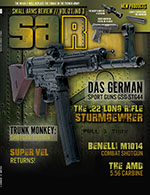The Winchester Model 1897 Shotgun
By Tom Murphy
The Winchester Model 1897 shotgun was manufactured from 1897 to 1957. Over 1,024,000 were built during that period. This John Moses Browning design was first offered as a 12-gauge solid frame, but a takedown was added in October of 1898 as well as a 16-gauge in February 1900. The M1897 was produced as a stronger, improved version of the M1893. The one major improvement over the M1893 was the slide lock which kept the action locked until the shotgun had fired, which in turn eliminated jamming from a misfire.
The M1897 is an external hammer shotgun that lacks a trigger disconnector. This means the shotgun can be fired simply by holding the trigger back and pumping the slide. The gun will fire every time the slide is returned to battery. The shotgun was available in various grades from the plain $25.00 grade up to the Tournament grade which retailed for $100. The less expensive grades were the Brush, Brush Takedown, Riot and the gun featured here–the Trench Gun. These were intended for rough use, so they were very plain.
Military Use
When the United States entered World War I it soon became clear that this would be a brutal war fought from trenches. There was a need for a large amount of close-range firepower when assaulting trenches. The M1897 Trench Gun became the close-in weapon of choice for this type of fighting. The gun was modified by adding a combination heat shield/bayonet lug that would mount a M1917 bayonet to a 20-inch cylinder bore barrel. The heat shield was perforated to allow heat to dissipate from the barrel, which prevented the soldier from burning his hands when he gripped the barrel. The 16-inch M1917 bayonet had originally been designed for the US M1917 Enfield .30-06 rifle but did an excellent job when fitted to the M1897 Trench Gun. It was also fitted to the Winchester M1912 shotgun, the Stevens M520-30, the M620 trench gun, the Remington M10 trench gun, Ithaca M37 trench gun and the Winchester M1200 trench gun. It saw service all the way to the end of the Vietnam War.
The Army and Marines used the M1897 for other purposes than trench cleaning. It was issued to troops who had previous shotgun experience and was used to shoot at grenades in the air. Hitting one with a buckshot load would cause it to veer off course and not drop in the trench. The shotgun was also employed as a guard gun on military bases.
Buckshot was issued with the M1897 during WWI. Shells were either 2-5/8 or 2-3/4 inches in length. Each shell contained nine 00 buckshot pellets. This meant that with its six-round capacity and its non-PC method of operation, it could put 54 .33 caliber pellets into a trench as fast as the slide could be pumped. The M1897 was so effective that the German government protested its use–I guess their Maxim machineguns were agreeable, though.
The Germans Protest
After being on the receiving end of a load of 00 buckshot, the Germans soon issued a protest against its use in combat. On September 19, 1918, their government alleged that the M1897 was prohibited by the law of war. In part, they stated that “it is especially forbidden to employ arms, projections, or materials calculated to cause unnecessary suffering.” Evidently they felt machine guns were Ok, but the M1897 wasn’t. The US Secretary of State rejected the protest. The Germans countered by issuing threats against any American soldier captured with a shotgun. The US issued a statement that, in effect, it would do the same to captured German soldiers.
This article first appeared in Small Arms Review V21N3 (April 2017) |
| SUBSCRIBER COMMENT AREA |
Comments have not been generated for this article.



